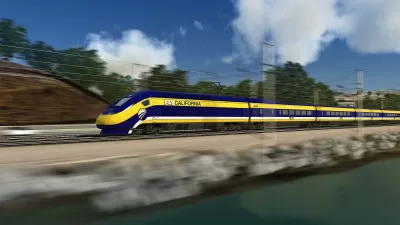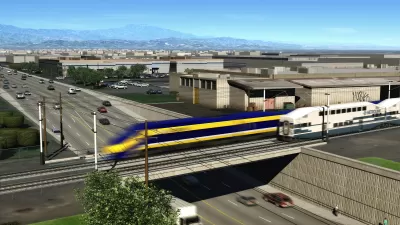In the face of political opposition and mounting construction costs in Southern California, the state High-Speed Rail Authority has chosen to build north from the Central Valley to San Jose rather than south from Fresno to the San Fernando Valley.
To be clear, the "initial operating section" included both the northern and southern sections in 2011. The decision by the California High-Speed Rail Authority to change course and build from Kern County to San Jose will save money and time due to the formidable tunneling costs under the Tehachapi and San Gabriel Mountains and local political opposition in the Palmdale to Burbank section.
"The high-speed rail authority said shifting to the Bay Area will allow it to have the initial segment operating by 2025, earlier than planned, which will make the project attractive to private investors that would help fill holes in funding," write Dan Weikel and Ralph Vartabedian for the Los Angeles Times.
"The math is pretty clear," said Dan Richard, chairman of the board that oversees the project in an AP article. "It’s just longer and more expensive to get to L.A. And looking at the available funds, we just couldn’t get there."
The change of Initial Operating Section was contained in the new Draft 2016 Business Plan [PDF] released Thursday, Feb. 18.
"It’s a major strategic pivot for the rail agency, which in its 2012 and 2014 versions of the business plan had proposed a route from Merced southward through the Valley to Bakersfield, then southeast to Palmdale and on to the San Fernando Valley and Los Angeles," writes Tim Sheehan for The Fresno Bee.
Sheehan goes into the funding numbers in detail for the northern route to San Jose, writing that it "leaves a gap of about $14 billion to get from the Valley over Pacheco Pass to Gilroy and San Jose."
Construction work began over a year ago in Fresno. Last week, the authority appeared in court in Sacramento facing what may be "the most serious challenge to the entire project," write Ralph Vartabedian and Marc Vartabedian.
It is the second lawsuit filed by attorneys for Kings County and two Central Valley farmers that charges that the project "violates state law because it is not financially viable, will operate slower than promised and has compromised its design by using existing shared tracks in the Bay Area." [Outcome of first lawsuit.]
No word on when Judge Michael Kenny will deliver his ruling, but reporters speculated it will take at least a few weeks. "No matter how Kenny eventually rules, it’s a near certainty that whichever side loses will appeal the decision to the state’s court of appeal," writes Sheehan.
FULL STORY: Change in bullet train construction plans will delay rail line's arrival in Southern California

Maui's Vacation Rental Debate Turns Ugly
Verbal attacks, misinformation campaigns and fistfights plague a high-stakes debate to convert thousands of vacation rentals into long-term housing.

Planetizen Federal Action Tracker
A weekly monitor of how Trump’s orders and actions are impacting planners and planning in America.

In Urban Planning, AI Prompting Could be the New Design Thinking
Creativity has long been key to great urban design. What if we see AI as our new creative partner?

King County Supportive Housing Program Offers Hope for Unhoused Residents
The county is taking a ‘Housing First’ approach that prioritizes getting people into housing, then offering wraparound supportive services.

Researchers Use AI to Get Clearer Picture of US Housing
Analysts are using artificial intelligence to supercharge their research by allowing them to comb through data faster. Though these AI tools can be error prone, they save time and housing researchers are optimistic about the future.

Making Shared Micromobility More Inclusive
Cities and shared mobility system operators can do more to include people with disabilities in planning and operations, per a new report.
Urban Design for Planners 1: Software Tools
This six-course series explores essential urban design concepts using open source software and equips planners with the tools they need to participate fully in the urban design process.
Planning for Universal Design
Learn the tools for implementing Universal Design in planning regulations.
planning NEXT
Appalachian Highlands Housing Partners
Mpact (founded as Rail~Volution)
City of Camden Redevelopment Agency
City of Astoria
City of Portland
City of Laramie




























